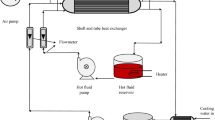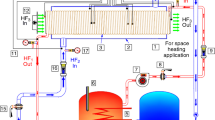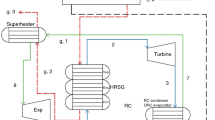Abstract
This study aims to experimentally investigate the impact of air bubbles injection on the combined energetic, exergetic, and economic performance characteristics of a plate heat exchanger (P-HEX) with a parallel fluid flow configuration. Cold water, with a fixed volume flow rate of 290 LPH, is mixed with air bubbles (flow rates ranging from 150 to 840 LPH) before entering the P-HEX. The hot water was studied in seven different volume flow rates (280 to 880 LPH) and kept at 50 °C. The results show remarkable increments in the enhancement factors of the number of transfer units and effectiveness, up to 33.17 and 5.5%, respectively, compared to single-phase flow. Furthermore, cold-water side injection boosts the maximum enhancement in the number of transfer units by 2.68 folds, compared to hot water side injection. The maximum entropy generation rate is dampened by 2.45 folds when injecting the cold-water stream instead of the hot one, and the maximum system efficiency is increased from 96.9 to 97.6%. The thermo-economic assessment further highlights the potential of air injection as one of the promising techniques for P-HEXs’ performance, where a maximum specific net profit of 0.45 USD kJ−1 is estimated.









Similar content being viewed by others
Data availability
All analyzed data in this study are described in the article itself or its electronic annex.
Abbreviations
- ABI:
-
Air bubble injection
- CWB:
-
Cold-water bench
- CWS:
-
Cold-water side/stream
- EGM:
-
Entropy generation minimization
- HEX:
-
Heat exchanger
- HTR:
-
Heat transfer rate
- HWB:
-
Hot water bench
- HWS:
-
Hot water side/stream
- P-HEX:
-
Plate heat exchanger
- TBL:
-
Thermal boundary layer
- THP:
-
Thermo-hydraulic performance
- \(A\) :
-
Heat transfer area (m2)
- \({A}_{\mathrm{p}}\) :
-
Plate area (m2)
- \(\mathrm{AOT}\) :
-
Annual operating time (s)
- \(\mathrm{AEGN}\) :
-
Augmentation entropy generation number
- \(C\) :
-
Heat capacity rate (J s−1 K−1)
- \({C}_{\mathrm{p}}\) :
-
Specific heat capacity (J kg−1 K−1)
- \(\mathrm{CF}\) :
-
Capital recovery factor (-)
- \(\mathrm{EGN}\) :
-
Entropy generation number (-)
- \(\mathrm{EGR}\) :
-
Entropy generation rate (W K−1)
- ER:
-
Effectiveness enhancement ratio (-)
- \(\mathrm{Ex}\) :
-
Exergy (J)
- \({\mathrm{Ex}}_{\mathrm{des}}\) :
-
Exergy destruction rate (W)
- \(f\) :
-
Friction factor (-)
- \(h\) :
-
Heat transfer coefficient (W m−2 K−1)
- \(i\) :
-
Interest rate (%)
- \({I}_{\mathrm{i}}\) :
-
Initial cost of P-HEX (USD)
- \(\mathrm{LMTD}\) :
-
Logarithmic mean temperature difference (°C)
- \(\dot{m}\) :
-
Mass flow rate (kg s−1)
- \(N\) :
-
Number of plates (-)
- \(n\) :
-
Lifetime of P-HEX (years)
- \(\mathrm{NP}\) :
-
Net profit value (USD)
- \(\mathrm{Nu}\) :
-
Nusselt number (-)
- \({N}_{\mathrm{t}}\) :
-
Number of P-HEX plates (-)
- \(\mathrm{NTU}\) :
-
Number of heat transfer units (-)
- NR:
-
NTU enhancement ratio (-)
- \(P\) :
-
Pressure (Pa)
- \(\dot{Q}\) :
-
Heat transfer rate (W)
- \(\mathrm{Re}\) :
-
Reynolds number (-)
- \(\mathrm{SV}\) :
-
P-HEX’s salvage value (USD)
- \(T\) :
-
Temperature (°C)
- \(U\) :
-
Overall heat transfer coefficient (W m−2 K−1)
- \(u\) :
-
Uncertainty (-)
- \(\dot{V}\) :
-
Flow rate (LPH)
- \(\mathrm{WF}\) :
-
Worth capital factor (-)
- \(\Delta P\) :
-
Pressure losses (Pa)
- \(\Delta {E}_{\mathrm{p}}\) :
-
Gain of thermal exergy (J)
- \(\Delta E_{{\text{q}}}\) :
-
Lost exergy due to friction (J)
- \(\varepsilon\) :
-
Energy effectiveness (-)
- \({\varepsilon }_{\mathrm{p}}\) :
-
Cost of each unit of friction exergy (USD J−1)
- \({\varepsilon }_{\mathrm{q}}\) :
-
Cost of each unit of thermal exergy (USD J−1)
- \({\varepsilon }_{\mathrm{Ex}}\) :
-
Exergy effectiveness (-)
- \({\eta }_{\mathrm{P}}\) :
-
Net profit per unit transferred heat load (USD kJ−1)
- \({\eta }_{W-S}\) :
-
Witte-Shamsundar efficiency (%)
- \(\rho\) :
-
Density of water (kg m−3)
- \(a\) :
-
Ambient
- \(\mathrm{actual}\) :
-
Actual
- \(\mathrm{air}\) :
-
Air
- \(\mathrm{avg}\) :
-
Average
- \(c\) :
-
Cold fluid
- \(h\) :
-
Hot fluid
- \(i\) :
-
Inlet or initial
- \(\mathrm{max}\) :
-
Maximum
- \(\mathrm{min}\) :
-
Minimum
- \(o\) :
-
Outlet
- \(p\) :
-
Plate
- \(\mathrm{sp}\) :
-
Single-phase fluid flow
- \(t\) :
-
Total
- \(\mathrm{tp}\) :
-
Two phase fluid flow
References
Hassan MA, Al-Tohamy AH, Kaood A. Hydrothermal characteristics of turbulent flow in a tube with solid and perforated conical rings. Int Commun Heat Mass Transf. 2022;134:106000. https://doi.org/10.1016/j.icheatmasstransfer.2022.106000.
Fadodun OG, Kaood A, Hassan MA. Investigation of the entropy production rate of ferrosoferric oxide/water nanofluid in outward corrugated pipes using a two-phase mixture model. Int J Therm Sci. 2022;178:107598. https://doi.org/10.1016/j.ijthermalsci.2022.107598.
Hassan MA, Kassem MA, Kaood A. Numerical investigation and multi-criteria optimization of the thermal–hydraulic characteristics of turbulent flow in conical tubes fitted with twisted tape insert. J Therm Anal Calorim. 2022;147:6847–68. https://doi.org/10.1007/s10973-021-10998-7.
Pandya NS, Shah H, Molana M, Tiwari AK. Heat transfer enhancement with nanofluids in plate heat exchangers: a comprehensive review. Eur J Mech B/Fluids. 2020;81:173–90.
Abou Elmaaty TM, Kabeel AE, Mahgoub M. Corrugated plate heat exchanger review. Renew Sustain Energy Rev Elsevier Ltd. 2017;70:852–60.
Sundar LS, Punnaiah V, Sharma KV, Chamkha AJ, Sousa ACM. Thermal entropy and exergy efficiency analyses of nanodiamond/water nanofluid flow in a plate heat exchanger. Diam Relat Mater. 2021;120:108648.
Amiri Delouei A, Atashafrooz M, Sajjadi H, Karimnejad S. The thermal effects of multi-walled carbon nanotube concentration on an ultrasonic vibrating finned tube heat exchanger. Int Commun Heat Mass Transf. 2022;135:106098.
Amiri Delouei A, Sajjadi H, Atashafrooz M, Hesari M, Ben Hamida MB, Arabkoohsar A. Louvered fin-and-flat tube compact heat exchanger under ultrasonic excitation. Fire. 2022;6:13.
Amiri Delouei A, Sajjadi H, Ahmadi G. Ultrasonic vibration technology to improve the thermal performance of CPU water-cooling systems: experimental investigation. Water Switzerland. 2022. https://doi.org/10.3390/w14244000.
Marouf ZM, Fouad MA, Hassan MA. Experimental investigation of the effect of air bubbles injection on the performance of a plate heat exchanger. Appl Therm Eng. 2022;217:119264.
Lowrey S, Hughes C, Sun Z. Thermal-hydraulic performance investigation of an aluminium plate heat exchanger and a 3D-printed polymer plate heat exchanger. Appl Therm Eng. 2021;194:117060.
Al Zahrani S, Islam MS, Xu F, Saha SC. Thermal performance investigation in a novel corrugated plate heat exchanger. Int J Heat Mass Transf. 2020;148:119095.
Panday NK, Singh SN. Study of thermo-hydraulic performance of chevron type plate heat exchanger with wire inserts in the channel. Int J Therm Sci. 2022;173:107360.
Nguyen DH, Kim KM, Nguyen Vo TT, Shim GH, Kim JH, Ahn HS. Improvement of thermal-hydraulic performance of plate heat exchanger by electroless nickel, copper and silver plating. Case Stud Therm Eng. 2021;23:100797.
Abbas A, Lee H, Sengupta A, Wang CC. Numerical investigation of thermal and hydraulic performance of shell and plate heat exchanger. Appl Therm Eng. 2020;167:114705.
Durmuş A, Benli H, Kurtbaş I, Gül H. Investigation of heat transfer and pressure drop in plate heat exchangers having different surface profiles. Int J Heat Mass Transf. 2009;52:1451–7.
Hassan MA, Hassan MA, Banerjee D, Hegab H. Evolutionary optimization of thermo-physical properties of MWCNT-Fe3O4/water hybrid nanofluid using least-squares support vector regression-based models. Appl Soft Comput. 2022;130:109644. https://doi.org/10.1016/j.asoc.2022.109644.
Zhang J, Zhu X, Mondejar ME, Haglind F. A review of heat transfer enhancement techniques in plate heat exchangers. Renew Sustain Energy Rev. 2019;101:305–28. https://doi.org/10.1016/j.rser.2018.11.017.
Kumar V, Tiwari AK, Ghosh SK. Application of nanofluids in plate heat exchanger: a review. Energy Convers Manag. 2015;105:1017–36.
Saleh B, Sundar LS. Experimental study on heat transfer, friction factor, entropy and exergy efficiency analyses of a corrugated plate heat exchanger using Ni/water nanofluids. Int J Therm Sci. 2021;165:106935.
Ajeeb W, Thieleke da Silva RRS, Murshed SMS. Experimental investigation of heat transfer performance of Al2O3 nanofluids in a compact plate heat exchanger. Appl Therm Eng. 2023;218:119321.
Göltaş M, Gürel B, Keçebaş A, Akkaya VR, Güler OV, Kurtuluş K, et al. Thermo-hydraulic performance improvement with nanofluids of a fish-gill-inspired plate heat exchanger. Energy. 2022;253:124207.
Niknejadi M, Afrand M, Karimipour A, Shahsavar A, Meghdadi Isfahani AH. Experimental investigation of the hydrothermal aspects of water–Fe3O4 nanofluid inside a twisted tube. J Therm Anal Calorim. 2021;143:801–10.
Karimi S, Heyhat MM, Isfahani AHM, Hosseinian A. Experimental investigation of convective heat transfer and pressure drop of SiC/water nanofluid in a shell and tube heat exchanger. Heat Mass Transf und Stoffuebertragung. Heat Mass Transf. 2020;56:2325–31.
Zhao J, Reda SA, Al-Zahrani KS, Kumar Singh P, Talal Amin M, Tag-Eldin E, et al. Hydro-thermal and economic analyses of the air/water two-phase flow in a double tube heat exchanger equipped with wavy strip turbulator. Case Stud Therm Eng. 2022;37:102260.
Zhou X, Bai H, Xu Q, Mansir IB, Ayed H, Abbas SZ, et al. Evaluations on effect of volume fraction of injected air on exergo-economic performance of a shell and tube heat exchanger. Case Stud Therm Eng. 2022;35:101919. https://doi.org/10.1016/j.csite.2022.101919.
Moria H. Compound usage of twisted tape turbulator and air injection for heat transfer augmentation in a vertical straight tube with upward stream. Case Stud Therm Eng. 2021;25:100854.
Marouf ZM, Fouad MA. Combined energetic and exergetic performance analysis of air bubbles injection into a plate heat exchanger: an experimental study. Energies. 2023;16:1164.
Kitagawa A, Denissenko P, Murai Y. Effect of heated wall inclination on natural convection heat transfer in water with near-wall injection of millimeter-sized bubbles. Int J Heat Mass Transf. 2017;113:1200–11.
Tsao H, Koch DL. Observations of high Reynolds number bubbles interacting with a rigid wall. Phys Fluids. 1997;9:44–56.
Donnelly B, O’Donovan TS, Murray DB. Bubble enhanced heat transfer from a vertical heated surface. J Enhanc Heat Transf. 2008;15:159–69.
Cornwell K. The influence of bubbly flow on boiling from a tube in a bundle. Int J Heat Mass Transf. 1990;33:2579–84.
Houston SD, Cornwell K. Heat transfer to sliding bubbles on a tube under evaporating and non-evaporating conditions. Int J Heat Mass Transf. 1996;39:211–4.
Donoghue DB, Albadawi A, Delauré YMC, Robinson AJ, Murray DB. Bubble impingement and the mechanisms of heat transfer. Int J Heat Mass Transf. 2014;71:439–50.
Balzán MA, Sanders RS, Fleck BA. Bubble formation regimes during gas injection into a liquid cross flow in a conduit. Can J Chem Eng. 2017;95:372–85. https://doi.org/10.1002/cjce.22680.
Sadighi Dizaji H, Jafarmadar S, Abbasalizadeh M, Khorasani S. Experiments on air bubbles injection into a vertical shell and coiled tube heat exchanger; exergy and NTU analysis. Energy Convers Manag. 2015;103:973–80. https://doi.org/10.1016/j.enconman.2015.07.044.
Moosavi A, Abbasalizadeh M, Sadighi DH. Optimization of heat transfer and pressure drop characteristics via air bubble injection inside a shell and coiled tube heat exchanger. Exp Therm Fluid Sci. 2016;78:1–9. https://doi.org/10.1016/j.expthermflusci.2016.05.011.
Ghashim SL, Flayh AM. Experimental investigation of heat transfer enhancement in heat exchanger due to air bubbles injection. J King Saud Univ Eng Sci. 2021;33:517–24. https://doi.org/10.1016/j.jksues.2020.06.006.
Ghashim SL. Study effect of bubble size on drag reduction. 10th PARIS Int Conf Adv Sci Eng Technol. Paris, France: Universal Researchers; 2018.
Baqir AS, Mahood HB, Kareem AR. Optimisation and evaluation of NTU and effectiveness of a helical coil tube heat exchanger with air injection. Therm Sci Eng Prog. 2019;14:100420. https://doi.org/10.1016/j.tsep.2019.100420.
FOETH. Tranter GLP-008 PI - Plate heat exchanger [Internet]. 2022 [cited 2022 Mar 13]. https://www.foeth.com/en/heat-exchangers/plate-heat-exchangers/tranter-glp-008-pi-plate-heat-exchanger-016h038#
Sinaga N, Khorasani S, Sooppy Nisar K, Kaood A. Second law efficiency analysis of air injection into inner tube of double tube heat exchanger. Alex Eng J. 2021;60:1465–76.
Khorasani S, Moosavi A, Dadvand A, Hashemian M. A comprehensive second law analysis of coil side air injection in the shell and coiled tube heat exchanger: an experimental study. Appl Therm Eng. 2019;150:80–7. https://doi.org/10.1016/j.applthermaleng.2018.12.163.
Moffat RJ. Describing the uncertainties in experimental results. Exp Therm Fluid Sci. 1988;1:3–17.
Pandey SD, Nema VK. An experimental investigation of exergy loss reduction in corrugated plate heat exchanger. Energy. 2011;36:2997–3001.
Attalla M, Maghrabie HM. Investigation of effectiveness and pumping power of plate heat exchanger with rough surface. Chem Eng Sci. 2020;211:115277.
Andrzejczyk R, Muszynski T, Kozak P. Experimental investigation on straight and u-bend double tube heat exchanger with active and passive enhancement methods. Grądziel S, Łopata S, Sobota T, Zima W, editors. MATEC Web Conf. 2018;240:02001. https://doi.org/10.1051/matecconf/201824002001
Yilmaz M, Sara O, Karsli S. Performance evaluation criteria for heat exchangers based on second law analysis. Exergy An Int J. 2001;1:278–94.
Bejan A. Advanced engineering thermodynamics. 4th ed. Hoboken, New Jersey: Wiley; 2016. https://doi.org/10.1002/9781119245964.
Tiwari AK, Ghosh P, Sarkar J. Combined energy and exergy analysis of a corrugated plate heat exchanger and experimental investigation. Int J Exergy. 2014;15:395–411.
Witte LC, Shamsundar N. A thermodynamic efficiency concept for heat exchange devices. J Eng Gas Turbines Power. 1983;105:199–203.
Bejan A. Entropy generation optimization: The method of thermodynamic optimization of finite-size systems and finite-time processes. 1st ed. Boca Raton: CRC Press Inc.; 1995.
Ham J, Kim J, Cho H. Theoretical analysis of thermal performance in a plate type liquid heat exchanger using various nanofluids based on LiBr solution. Appl Therm Eng. 2016;108:1020–32. https://doi.org/10.1016/j.applthermaleng.2016.07.196.
Khorasani S, Dadvand A. Effect of air bubble injection on the performance of a horizontal helical shell and coiled tube heat exchanger: an experimental study. Appl Therm Eng. 2017;111:676–83. https://doi.org/10.1016/j.applthermaleng.2016.09.101.
Buscher S. Visualization and modelling of flow pattern transitions in a cross-corrugated plate heat exchanger channel with uniform two-phase distribution. Int J Heat Mass Transf. 2019;144:118643.
Cao Y, Nguyen PT, Jermsittiparsert K, Belmabrouk H, Alharbi SO, Khorasani MS. Thermal characteristics of air-water two-phase flow in a vertical annularly corrugated tube. J Energy Storage. 2020;31:101605. https://doi.org/10.1016/j.est.2020.101605.
Funding
No funding was received to assist with the preparation of this manuscript.
Author information
Authors and Affiliations
Contributions
ZMM helped in conceptualization, methodology, software, validation, formal analysis, investigation, data curation, visualization, writing—original draft, writing—review and editing, resources. MAH contributed to conceptualization, formal analysis, visualization, writing—original draft, writing—review & editing, supervision. MAF was involved in writing—review and editing, supervision.
Corresponding author
Ethics declarations
Conflict of interest
The authors declare that they have no known competing financial interests or personal relationships that could have appeared to influence the work reported in this paper.
Additional information
Publisher's Note
Springer Nature remains neutral with regard to jurisdictional claims in published maps and institutional affiliations.
Supplementary Information
Below is the link to the electronic supplementary material.
Rights and permissions
Springer Nature or its licensor (e.g. a society or other partner) holds exclusive rights to this article under a publishing agreement with the author(s) or other rightsholder(s); author self-archiving of the accepted manuscript version of this article is solely governed by the terms of such publishing agreement and applicable law.
About this article
Cite this article
Marouf, Z.M., Hassan, M.A. & Fouad, M.A. Energy, exergy, and economic (3E) analysis of air bubbles injection into plate heat exchangers. J Therm Anal Calorim 148, 6311–6325 (2023). https://doi.org/10.1007/s10973-023-12143-y
Received:
Accepted:
Published:
Issue Date:
DOI: https://doi.org/10.1007/s10973-023-12143-y




